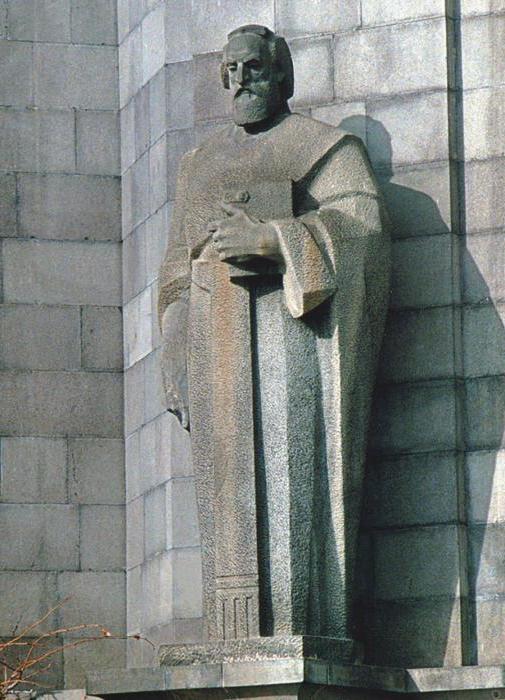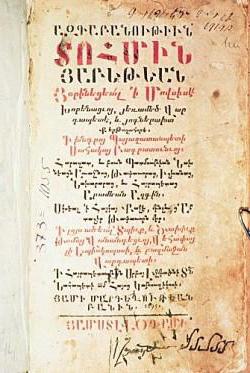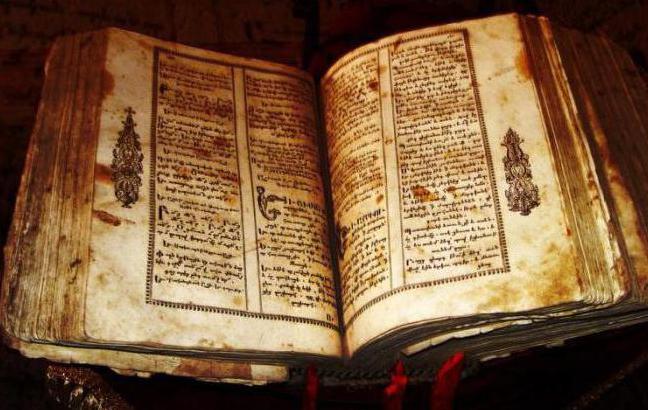Armenian historiography is the oldest inTranscaucasia. At the time when the first Georgian chroniclers began to write their works in the 9th-10th centuries, works by Khazar Parpetsi, Favst of Byzantium, Koryun, Egishe and Movses Khorenatsi were already stored in Byzantine libraries. The latter received the nickname Kertokhaire, which translates as "the father of historians." Information from his works sheds light on the most ancient history of Armenia and is a source of information on neighboring countries that existed in the Near East up to the 5th-6th century of our era.

Movses Khorenatsi: a biography in his youth
Reliable information about the life of the chroniclerare absent. The only source of information about Khorenatsi's life is his work "The History of Armenia", in which he sometimes makes digressions and cites some facts about events that happened personally with him.
Traditionally it is considered that the historian was bornin the village of Khoren in Syunik region in the 5th century. It is with its name associated with the nickname of the chronicler. It is translated as "Movses from Khoren". According to the author's story, he received primary education in his native village, where a school founded by the creator of the Armenian script Mesrop Mashtots operated. Later he was sent to study in Vagharshapat, where Movses Khorenatsi studied Greek, Pahlavi (Middle Persian), and Syriac. Then, among the best students, he was sent to continue his education in the city of Edessa, which at that time was one of the most important cultural centers of the whole region. The successes of the young schoolboy were so obvious that he received recommendations and went to study in Alexandria - one of the greatest cities of the Roman Empire of the late period, where he thoroughly acquainted with the Neoplatonic philosophy.

After returning home
It is believed that, after returning to Armenia, MovsesKhorenatsi, together with Mashtots and his other students, translated the Bible into Armenian, becoming one of the first "Targmanich". Later all these clergymen were ranked as saints.
Death
In 428, Armenia was captured and dividedbetween the Byzantine Empire and Persia. Before his death, Movses Khorenatsi wrote: "I'm crying and grieving for you, country Armenia ... You do not have a king anymore, there is no priest, there is no symbol and not even a teacher! Chaos reigned and Orthodoxy was shaken. Ignorance has sown pseudo-wisdom. Priests are arrogant self-lovers with penance on their lips, lazy, ambitious people who hate art and love holidays and libations ... ".

"History of Armenia"
This major work of the whole life of Movses Khorenatsicovers the period from the time of the formation of the Armenian people to the fifth century of our era. Its main value lies in the fact that this book is the first complete exposition of the history of the country. At the same time, it contains a presentation of mythology, works of oral folk art, pagan religion, semi-annihilated at the time of writing the manuscript, the inner life of the state and its political and economic ties with the world. It also contains various data on the culture and history of neighboring countries.
The annals consist of three parts:
- "Genealogy of the Great Armenia", including the chronicle of the country from its mythological origin to the foundation in 149th year BC of the Arshakid dynasty.
- "Statement of the average history of our ancestors" (until the death of St. Gregory the Illuminator).
- Conclusion (until 428 AD, when the fall of the Arshakid dynasty occurred, to which the Armenian historian himself was a witness).
Pseudo-Khorenatsi
There is also 4 part, which, in the opinion ofmost researchers, was written by an unknown author who brought the story before the reign of Emperor Zeno, which occurred for the period 474-491. The first 3 parts also contain anachronisms, contrary to the information reported by Lazar Parpetsi and Koryun. At the same time, the latter confirms in his writings the existence of a bishop named Movses.
Until now it remains unknown why the author andthe anonymous editor of the 4th part of the "History of Armenia" used the name of Movses Khorenatsi. There is a version that he intended to glorify the Bagratid dynasty, which since the end of the 7th century was the dominant one in the country. In 885, Ashot the First reigned on the throne. Most likely, the task of Pseudo-Khorenatsi was to create the ground for the rise of this dynasty.

Creation
The book "History of Armenia" by Movses Khorenatsi is notthe only literary work written by the chronicler. He is also known as a writer of church hymns, a poet and a grammar. Among his works can be noted:
- "Rhetoric."
- "Geography" (the author of this work, some researchers tend to think Ananiya Shirakatsi).
- "It's about the holy martyr Maiden Ripsime."
- "Instruction on the Transfiguration of Christ".
- "Comments on the Armenian grammar", etc.
As was the case with the first Armenianmonks-writers, in his writings, regardless of their content, there are digressions in which he tells everyday details or describes the events that occurred with the people around him at the time of work. Literary critics note the undoubted literary and poetic talent of Khorenatsi, which is especially evident in his hymns and sermons.

Scientific disputes
The fact that Movses Khorenatsi was really existingpersonality, are not currently challenged. However, many Western historians disagree with the fact that Khorenatsi lived in 400 years and insists that he carried out his activities much later, in the interval between the 7th and 9th centuries. The reason is the mention in the "History of Armenia" of a number of toponyms belonging to a later period. However, the Armenian explorers of the life of the chronicler argue, they were inserted later, by scribe monks, who replaced the outdated name of settlements, rivers and regions, modern ones.
The question is also placed on the fact thatKhorenatsi is a disciple of Mesrop Mashtots, since, perhaps, he called himself so in a figurative sense. The fact that Armenians still call the creator of their writing the Great Teacher speaks in favor of the latest version.
Some anachronisms in the text of "The History of Armenia"cast a shadow on the statement, according to which the customer of Khorenatsi was the king Sahak Bagratuni. Perhaps his name was also inscribed on the basis of political considerations.

The Armenian historian Khorenatsi played a huge role in thedevelopment of the culture of its people. Thanks to his monumental work spanning a period of several millennia, many myths and legends have reached us, and a holistic picture of the events and disasters that he lived through during his lifetime has been built.
Armenians to this day treat Khorenatsi with great respect, and every schoolboy knows about his contribution to the culture of his country.












